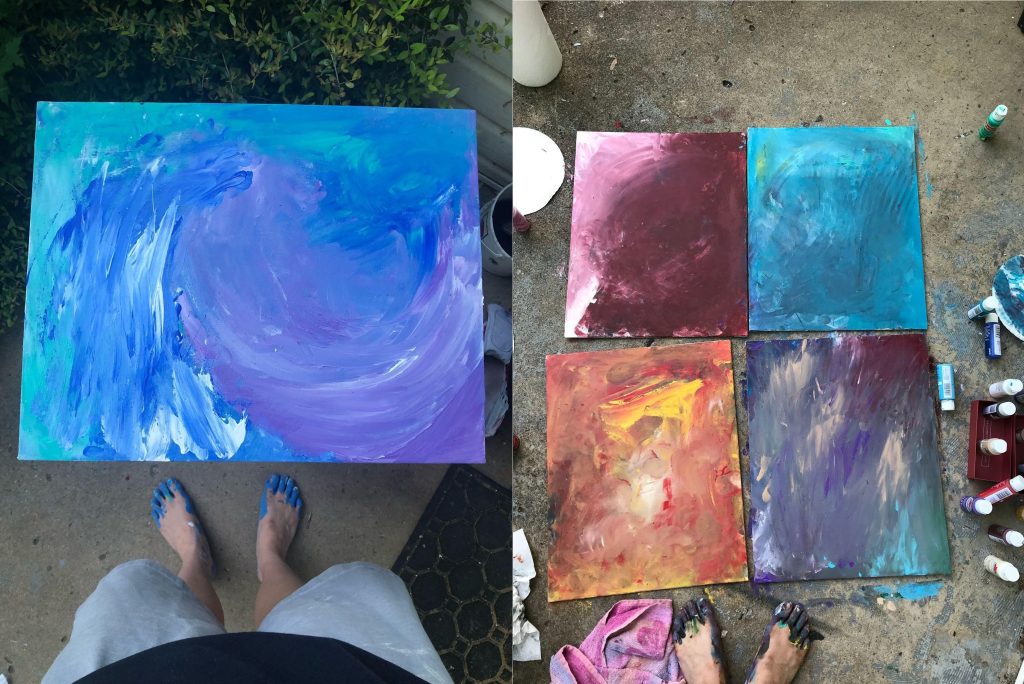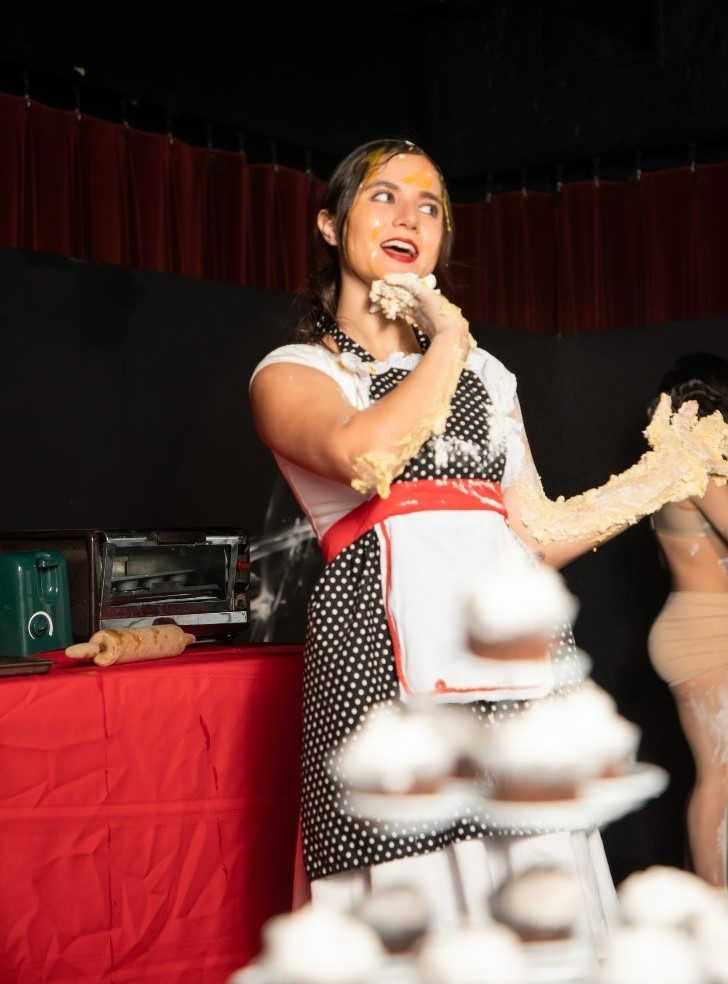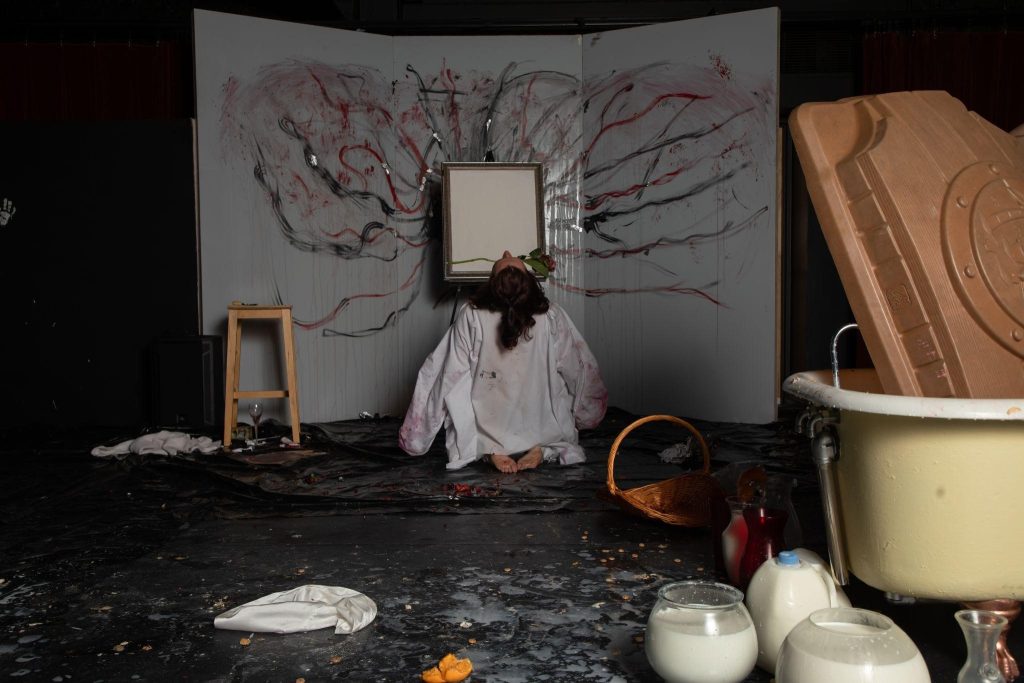The Creative Wire
Explosive Art: An Inside Look at the Creation of Rush Johnston’s Making a Mess
August 2, 2022 | by Rush Johnston
Edited by Christina Manceor
What do you do when the world around you is in ruins? Try to rebuild, or contribute to the rubble?
March 2020—an extended spring break, or so we thought. We were sent away from school for a short vacation, only to remain remote for the next six to ten months. All of a sudden, I didn’t have 20 square feet of space anymore, let alone a studio in which to process my grief or keep up my craft. Zoom classes became our new normal and they were impossible in my living room. I was at a loss with dance, coming up empty any time I tried to move and unable to access my traditional practice, so I started painting. I needed an artistic outlet and painting was the most accessible form even though I knew next to nothing about it.
I dove into this new world of visual art by creating abstract and figurative works, large and small, yet something was still missing. I was making work, but I wasn’t in it. So I took a canvas into my front yard and started dancing on it, painting with my feet as I improvised. It was a cathartic experience and filled the hole I’d been feeling throughout the initial months of the pandemic. It was new and exciting and I couldn’t get enough. I performed on Instagram and Facebook, sharing my dancing paintings with the FUSE student group and the wider internet audience. This was the first experience that made me stop and think about cross-disciplinary artistic practices in ways that I had never seen on the American proscenium stage, and it was just the tip of the iceberg.

Though COVID-19 has been extremely detrimental to traditional arts, it has also been a genesis for some digital art forms and other avant-garde styles. I looked to creators pioneering these new forms as I continued to question my current art form. What ways had I been bound to tradition in my craft? What room was there to grow, to explore? It struck me that I would have never been allowed to paint through dance on stage, and I began to wonder what else would be “prohibited” from my world of “fine art.” So often there are administrative barriers and economic challenges standing in the way of avant-garde work. I wasn’t sure exactly what my final project would look like, but I knew I wanted to create art that reflected the world around me, art with grit and grime and chaos. Around this time, I was also asked to begin planning for my capstone project, the project that would sum up my entire Peabody experience and showcase my point of view as a creator, choreographer, and dancer. I continued to question the fine art world and the barriers that often prevent me from making the art I felt called to create—art that was messy. So often fine art has a sense of refinement around it, a proscenium to perform in. It’s prim and proper and in a box. I love my classical roots and am so thankful for my study of traditional styles at Peabody, but I have a hunger for something new. So I dared to create it.
As I continued to imagine this capstone project, I kept dreaming of art that was actively messy, chaotic, and almost out of control—art that couldn’t be tamed by the institution or the social constructs it had to answer to. I knew I wanted to combine artistic styles and push boundaries of myself and the systems I was a part of. Thus Making a Mess was born.
Imagine the breaking of a vase, the smell of citrus wafting through the air, a bathtub full of milk, paint being flung on every surface, and the ability to walk through and see it all up close and personal. That is Making a Mess.

Making a Mess at its core is a gallery show that subverts common expectations around concert dance in order to question the systems “fine art” exists within. In this installation, dancers were positioned in vignettes throughout a gallery space that audience members could meander through, making the experience more intimate, three-dimensional, and engaging than works set on a traditional proscenium stage. Through experimental processes including scored improvisation and authentic movement practices, the dancers were able to develop their characters over the course of the creative process. This looked like hour-long sessions of character embodiment and improvised interactions as a method of further researching the work. The dancers worked with physical materials that are often not seen in traditional dance spaces, such as paint, fruit, and milk, as well as subject material that is often viewed as taboo in the dance world and its institutions. Many of these subject matters such as queerness, mental illness, and sensuality are permissible in other art areas like television and visual art but have been strongly discouraged in the concert dance world as a further enforcement of elitism. Making a Mess posed questions around the social systems concert dance exists within, including class, race, and gender identity.
I’d like to share some insights about what the process looked like behind the scenes to eventually culminate in this outside of the box production.

Applying for Funding
One of the most beneficial parts of this process was learning how to apply for funding to bring this project to life. I really appreciate the Pitching Your Creative Idea course that walked me through the grant writing process. Applying for funding has always been daunting to me, and the class broke it down into manageable steps that I could handle. I applied for and won three grants for this project: the Launch Grant, a Career Development Grant, and the MDEA Continued Studies Scholarship. I am so grateful for the support of these grants and to have been trusted with the funding to bring this project to life.
Finding a Venue
Access was a very important tenet of this project, so it was extremely important to me that this was a free performance at a community-based venue. Motor House was the perfect venue based on their mission of supporting local emerging artists and integrating arts into the community. Additionally, their connections to the community helped me reach audience members I wouldn’t have otherwise reached if I had held the show at Peabody. Making a Mess is designed to reflect back an image of the fine art world and question what even counts as art under the confines of elitism, making Motor House an excellent fit. It was a dream come true to find an arts space that would host such a project, and I hope to have the opportunity to produce with Motor House again in the future.

Collaboration
While I’ve always been a fan of collaborative processes, this has been such a process of growth for me as a director and choreographer. We began with individual rehearsals with each cast member, where I was attending 11 hours of rehearsal a week to workshop these ideas. I would begin by reading them a long list of materials and having a discussion about what they were drawn to. From there we began constructing the narrative elements through conversation, scoring, improvisation, and authentic movement. After about a month of this process, we started coming together for group rehearsals to further explore character development and relationships. We were continuously inventing new plot points and ideas in these rehearsals and the process was invigorating with creative energy. I truly felt that the dancers were deeply engaged with the authorship of their roles in the piece and that people wanted to deeply investigate their characters. Even the music was born from an ongoing collaboration with Charlie Reichert Powell, composer, (BM ‘23) and came together perfectly to fit the piece. This piece was collaborative and innovative at its heart and I want to continue to explore these paths in my future work.

Ultimately, this work was more than I could have ever dreamed. Even down to tech week and the live performances, I simply couldn’t have asked for a better outcome. I learned so much from being in the theater and managing a whole production week on my own including how to stay on schedule, strike each night, and remain flexible in the face of challenges. This piece came to life in ways that I had worked to plan for over a year, yet I still couldn’t have predicted their final outcome in a way that was so glorious and exciting. I cannot wait to continue producing, and Making a Mess has proven to me that I am meant to be creating in this capacity and continuing to push the boundaries of art in all that I do.
——————————————————————————————————————-

Rush Johnston
Dance
BFA 2022

Rush Johnston (they/them) is a Baltimore-based multimedia choreographer, performer, filmmaker, and movement researcher. Rush creates at the intersection of visual and performing art, often exploring modes of artistic expression beyond the binary. As a queer, Native, neurodiverse artist, their work often plays with perception and identity, inviting viewers to question proposed truths of self and social misunderstanding. Social justice work is a key element of Rush’s creative vision, often encompassing themes of political turmoil, queerness, and mental health.
Instagram: @rushj_dance